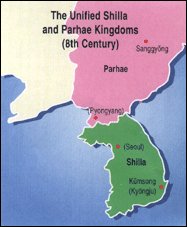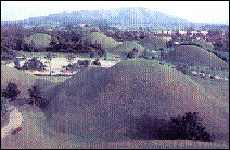KOREA>HISTORY>Unified Shilla and Parhae
![]()
4. Unified Shilla and Parhae
 Shilla thus unified Korea in 668, but the kingdom's reliance on Tang Dynasty
had its price. Eventually Shilla had to forcibly resist the imposition of
Chinese rule over the entire peninsula, which Shilla's rulers did, but their
strength did not extend beyond the Taedong River.
Shilla thus unified Korea in 668, but the kingdom's reliance on Tang Dynasty
had its price. Eventually Shilla had to forcibly resist the imposition of
Chinese rule over the entire peninsula, which Shilla's rulers did, but their
strength did not extend beyond the Taedong River. For two and a half centuries, Shilla enjoyed peace and prosperity. Freed from the worries of domestic conflicts and external invasions, it achieved rapid development in the arts, religion, commerce, education and all other fields. The Shilla capital, present-day Kyongju, had a population of over one million. Its citizens led affluent lives and the city boasted magnificent royal palaces and Buddhist temples. Buddhism flourished under the patronage of the nobility, exerting tremendous influence upon state affairs and artistic creation. Some of Korea's outstanding historical monuments are attributed to the creative genius and religious fervor of the artisans of this time. Among the monuments representing the great cultural flowering of the period are Pulguk Temple and Sokkuram Grotto Shrine, both located in the vicinity of Kyongju. Shilla reached the peak of its prosperity and power in the mid-eighth century. The Shilla ruling class began to fight among themselves, however, in the latter part of the eighth century, and in 918 Wang Kon, a rebel leader, founded the Koryo Dynasty. The modern name "Korea" comes from Koryo.  In
south central Manchuria, which had been part of Koguryo, the people of
Koguryo led by a former Koguryo general, Tae Cho-yong, repulsed Tang forces
in Manchuria and the northern part of the peninsula, and established the
Kingdom of Parhae in 698. In
south central Manchuria, which had been part of Koguryo, the people of
Koguryo led by a former Koguryo general, Tae Cho-yong, repulsed Tang forces
in Manchuria and the northern part of the peninsula, and established the
Kingdom of Parhae in 698. Parhae established a five regional-capital system of government based on Koguryo's administrative structure and possessed an advanced culture also based on Koguryo to the extent that China named it "the flourishing land in the east." At the height of its power, it occupied a vast territory reaching to the Amur River in the north and Kaiyuan in Manchuria to the west. Early on, it came into conflict with Tang and Shilla but later established peaceful relations with China. It also had diplomatic ties with the Turks and Japan. |
